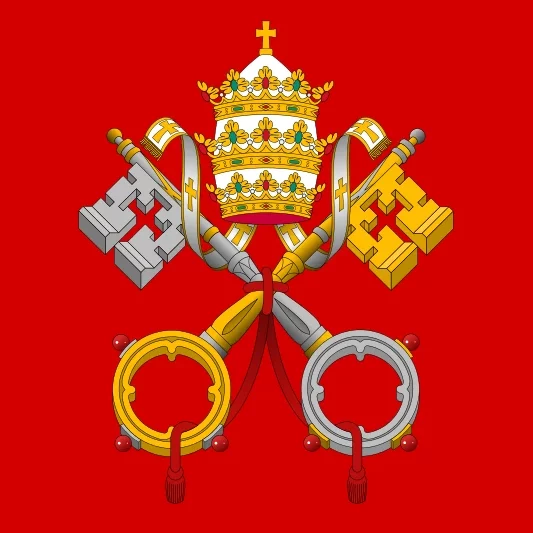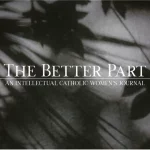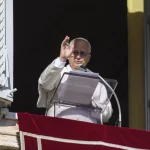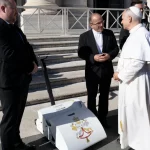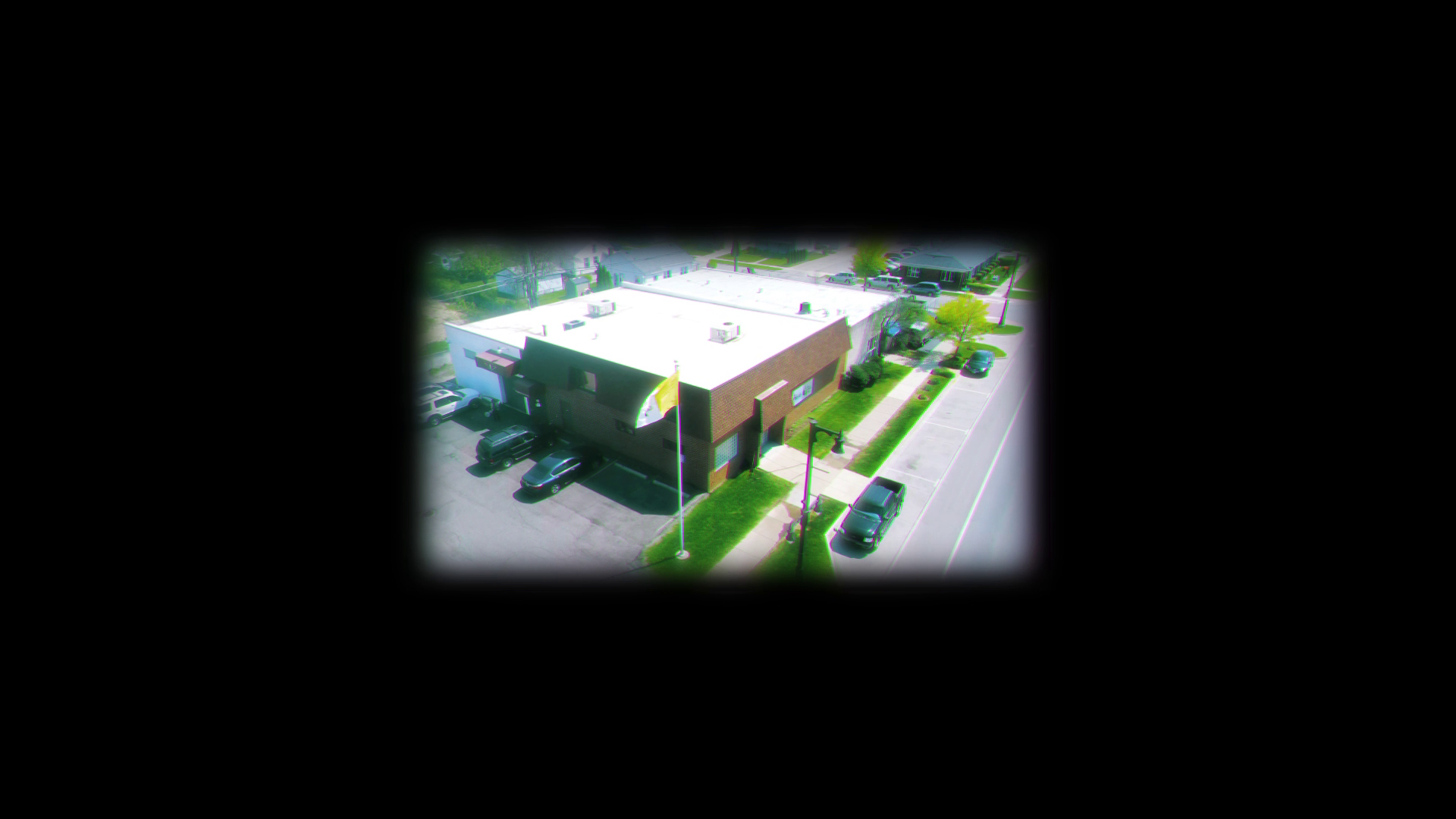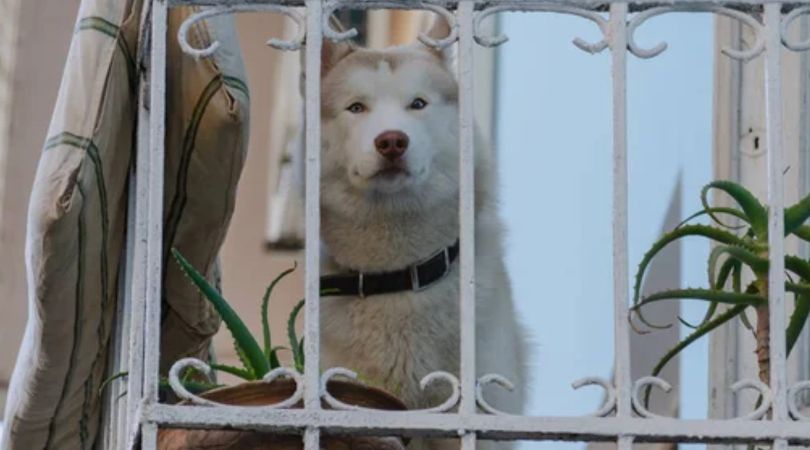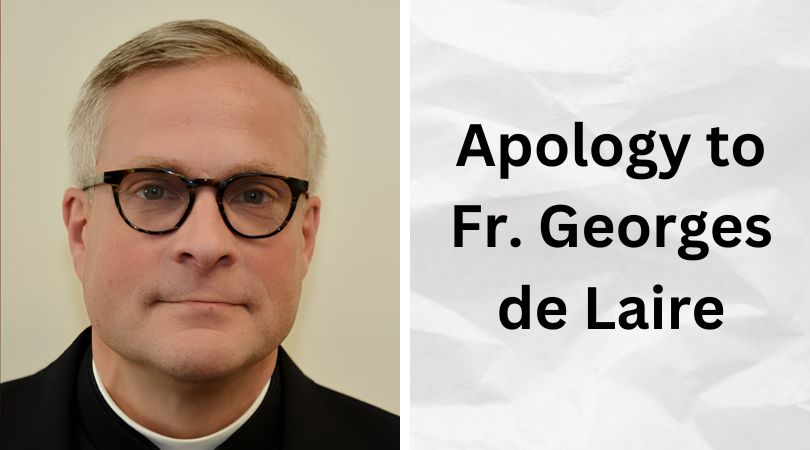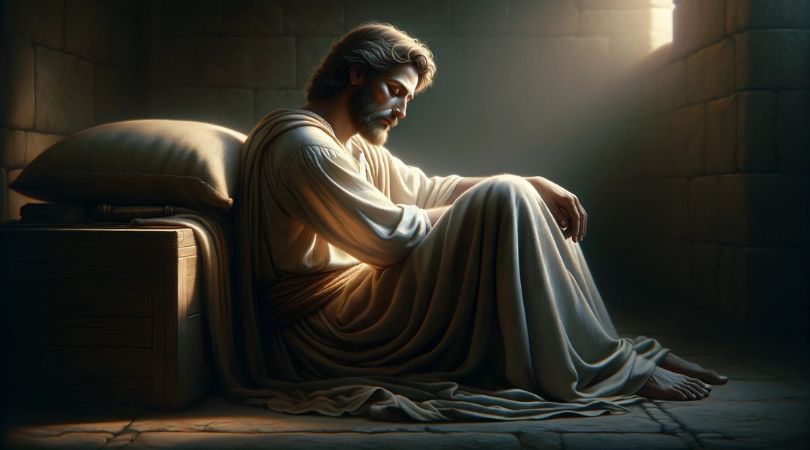VIENNA (ChurchMilitant.com) – A controversial art installation at St. Stephen’s Cathedral in Vienna that turns the Shroud of Turin upside down has sparked outrage among faithful Catholics.
Gottfried Helnwein
The Lenten cloth triptych is by Gottfried Helnwein, who has been dubbed a “shock painter” and a “rock star among hyperrealist artists with a penchant for provocation,” partly because of his realistic, dark depictions of injured children.
Helnwein, who says that “art needs no tasks and no rules; the only thing it needs is absolute freedom,” claims that the inverted Shroud of Turin flanked by two skulls is a reminder of human mortality.
On his website, Helnwein notes that the exhibit “represents an invitation and an offer to convey the central Christian message to people across narrow denominational boundaries using the contemporary language of art.”
The three Lenten cloths decorating the chancel of St. Stephen’s Cathedral are in liturgical purple with the centerpiece of Jesus Christ hanging upside down on a large replica shroud, which is placed behind the high altar of the famous cathedral.
A priest shocked by the installation said that he had attended Holy Mass where the cathedral dean, Fr. Toni Faber, explained to Sunday school children why Jesus had been turned upside down in the art exhibit.
“We are no longer shocked to see perverted works of arts in our churches,” the priest, who spoke on condition of anonymity, told Church Militant. “In Innsbruck, a picture of a pig’s heart in a condom was hung above the high altar, not to mention a half-naked man laying down in another image.”
Faber told the children that the artwork was meant to signify Jesus’ descent into Hell after His death on the Cross.
“If Faber is able to escape the responsibility that this is blasphemous art by a cunning explanation, it’s going to take a lot more effort on his part to explain as to why he chose Gottfried Helnwein to design this ‘work of art,'” the priest remarked.
On Holy Saturday, the second triptych will reveal the resurrection of Christ in front of the high altar. It will be a youthful Christ Who has been marked, using a golden light, by the crucifixion and the stigmata.
Shortly before Pentecost, a third triptych will show, using red flames, the sending of the Holy Spirit on many people, which depicts the hope for salvation for all, the artist explains.
Helnwein, who said he was a cultural Catholic, made his work available “for God’s reward” and did not charge the cathedral for his labor.
The anonymous priest attending Mass also told Church Militant that Helnwein was a close friend of rock musician Marilyn Manson, who married Dita Von Teese at Helnwein’s castle in 2005. Helnwein was Manson’s best man.
“Manson is an ‘honorary priest’ in the Church of Satan and has portfolios of blasphemous works, blaspheming the Bible, Jesus, the Virgin Mary and other aspects of the Catholic faith. Helnwein was also responsible for some of these works, like the photo of Manson standing in a pose mocking the sacred heart of Jesus,” the priest added.
“Christ is mocked in His cathedral by a wicked artist as His mockery is ordered by the cathedral provost whilst Cdl. Christoph Schönborn smiles on once again, and Catholics are forced to view this blasphemy,” the priest lamented.
The production costs for the three works are covered by the cathedral parish with the help of sponsors. Faber, who has been criticized for spending taxpayers’ money on “shock art,” emphasized that “not a cent of the church’s contribution goes into the project.”
In December 2022, Faber installed Helnwein’s poster of a blood-smeared girl on the south tower of the cathedral. Helnwein said that the poster was triggered by the killing of a young woman by Iran’s morality police for being “improperly dressed.”
Erwin Wurm’s ‘Purple Sweater’
In Lent 2023, Erwin Wurm, an Austrian artist notorious for “pushing the boundaries of sculpture,” displayed an 80-square-meter purple sweater hung over the baroque high altar, Church Militant reported.
The sweater is meant to replicate the purple veil fastentuch (fasting cloth) used to cover images of Jesus, especially the crucifix, in Catholic and some Protestant churches during Lent.
Weighing over 600 pounds and made in Thailand, the exhibit is designed to convey the message of a “warming and protective second skin,” supposedly alerting worshippers to “the priority of warming love of neighbor,” the cathedral’s website explained.
A number of Wurm’s other artworks could be classified as pornographic, including an image of two bare-breasted women posing side by side joined together by a single pair of underpants.
Other indecent images include a bare-breasted woman with legs spread and another of a woman posing with a scantily-clad posterior — both leaving little to the imagination.
The artist, a lapsed Catholic who says he has returned to the Church as a “cultural” Catholic, has also created images mocking priests and nuns. Another sculpture, titled “Confessional,” depicts two men inserting their heads into the opposite ends of a dog kennel.
Wurm’s ‘Confessional’ and other suggestive images (edited)
In April 2008, authorities at St. Stephen’s Cathedral caused outrage when they exhibited an art piece portraying the Last Supper as a homoerotic orgy. The exhibition, “Religion, Flesh and Power” by controversial sculptor Alfred Hrdlicka, depicted Jesus being fondled and the apostles groping one another.
Cardinal Schönborn, archbishop of Vienna, ordered the removal of the Last Supper exhibit, but other blasphemous pictures — including one showing Christ being fondled while on the Cross — were left on display.
In 2007, Faber invited all “lovers” to St. Stephen’s Cathedral to receive a “blessing” for St. Valentine’s Day, explicitly including homosexuals in his invitation.
In 2012, when asked by an Austrian women’s gossip magazine if priests were allowed to consume pornography, the pastor replied, “Watching porn is probably not a serious sin.”
